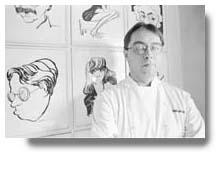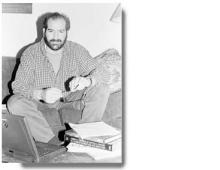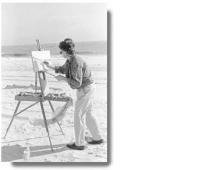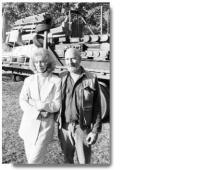Specialty Of The House: Della Femina
Specialty Of The House: Della Femina

Before going home for the night, Kevin Penner, the executive chef at Della Femina in East Hampton, served the evening's last meal - a simple feast of porcini mushrooms - to fresh snails just in from the Pacific Northwest. The snails were for the next day's menu, as were the wild Scottish red partridge he would spend Saturday afternoon checking over for buckshot.
Each week, sometimes daily, he transforms his menu in some way. Ingredients are ordered from around the world - bay scallops from Nantucket, fish from Seattle, game birds from Scotland - but always with an eye to creating dishes that reflect and complement the season.
"There are all these chefs looking at their menus and wonder ing why they can't buy nice tomatoes in November," Mr. Pen ner said. He believes it takes more than that to elevate a menu.
He never studied at a culinary institute, yet he has cooked his way to head one of the most highly touted restaurants on the South Fork.
"My career wasn't mapped out at all," he said, looking back on his days at the University of Iowa when he planned to pursue a Ph.D in philosophy and thought, perhaps, that cooking was just a way to pay tuition.
While turning out 1,700 to 2,100 dinners a week in the summer is probably more stressful than academia, he acknowledges that in many respects cooking is an intellectual endeavor. "There is a rationale in the way a menu is constructed, a logic in the preparations of food."
When he first began at Della Femina in 1992 as the chef de cuisine, he said, most of the restaurants in the area had the same menu - "a bastardized version of Tuscan cuisine, unfortunately all prepared the same way."
Items that are fairly standard in many restaurants like veal chops and chicken don't appeal to him and rarely have a place on his menus. Since moving into the position of executive chef last year, he has also cut down on the role of pasta at the restaurant.
"The whole point is to expose people to a wider variety of foodstuff," he said. He often gives diners a chance to try more unusual fare like squab, rabbit, or antelope. International ingredients notwithstanding, he describes his creations as contemporary American with influences from around the world.
"I'm American," he said. "I'm interested in preparing American food." To him that's anything but restricting.
"You have to tread the line between educating the dining public and running a business," he said. In his current position, his responsibilities extend beyond the kitchen. Ultimately he is responsible for the reputation and financial performance of the restaurant, and this year both look quite good. He's not a chef looking to open a restaurant of his own. In fact, "for the time being plus," he's looking to help open some more Della Femina's in Manhattan and perhaps elsewhere.
His appreciation for a fine meal began when growing up in Iowa, where each night his family sat down and ate together and on Sunday afternoon had a virtual feast.
"American families rarely do that now," he said, guessing the change has contributed to the rise in popularity of eating out. "Before, going out to eat was to celebrate, now it is a recreational activity."
"A lot of people come here just to feed. They tell you what they want, ask you to change your dishes," he said. In his three-star kitchen, Mr. Penner has prepared grilled cheese and hot dogs for children, made simple pasta with garlic and olive oil, and heated babies' milk bottles, when asked. He says he doesn't have a problem doing special orders or substituting one thing for another on a plate, but it "isn't very rewarding on an intellectual or artistic level."
"To see dining as recreation, you have to view it like theater. When you go, you don't request the director change the script. . . . You see people who want to be blown away and people who just want to drop food into their stomachs."
When a meal is an occasion, however, he feels people appreciate it more. His advice: Apply some sense of aestheticism, instead of asceticism. It's a potential work of art, enjoy it for that.
"A lot of places are facilities rather than restaurants," he said. Like a director, Mr. Penner has won critical acclaim for his creations, but the many returning faces in the dining room are the best compliments.
Grilled Hudson Valley Foie Gras
Ingredients:
1 foie gras, grade "A" (occasionally available locally at the Red Horse Market or by special order through D'Artag non, 1-800-327-8246)
6 Bosc pears, fully ripe, peeled, cored, and rubbed with lemon
3 cups dry white wine
3 cups water
2 cinnamon sticks
2 oranges, zest only
6 allspice berries, crushed
Ginger Sauce and Prunes
2 Tbsp. sugar
2 Tbsp. apple cider vinegar
2 cups strong veal stock
1 Tbsp. freshly minced ginger
4 allspice berries, crushed
6prunes, preferable Agen, or domestic, pitted
Method:
1. Remove foie gras from its package. Carefully separate the two lobes. Remove the fat and any loose veins from each lobe. Slice six 3-ounce pieces and score in a cross pattern with a warm wet knife. Place on a plate, cover with plastic wrap, and keep cold until needed.
2. Bring the water, wine, cinnamon, orange zest, and allspice to a boil. Place the pears in the liquid and poach at a simmer, until done or until a knife is easily inserted.
3. Drain the pears and puree in a blender or food processor until very smooth, adding a little poaching liquid if necessary. Set aside and keep warm.
4. Ginger sauce and prunes: Combine the sugar with just enough water to form a paste in a heavy saucepan. Cook until it reaches a light amber color. Deglaze with the vinegar and reduce by 30 percent. Add the veal stock, allspice, and ginger and reduce until sauce coats the back of a spoon. Strain sauce and keep warm on the side. Place the prunes in the sauce.
5. Prepare a charcoal grill or preheat a kitchen grill until very hot. Salt and pepper the foie gras to taste and grill 11/2 to 2 minutes. The process is smoky and you may have to move the foie gras around on the grill to keep flames from getting too hot. Turn it over and grill for the same amount of time on the other side. It is done when soft to the touch. Remove from grill and keep warm.
6. Spoon a dollop of pear puree onto six warm plates. Return the sauce to heat and bring to simmer. Place one piece of foie gras onto pear puree on each plate, top with a prune, and spoon the sauce over top. If any fat from the foie gras accumulates on the plate, drizzle it onto each serving.
Serves six.



